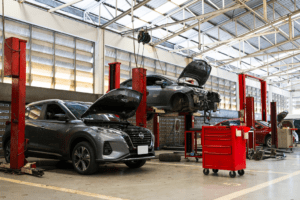Ferrari's Bad Tire Strategy at the Hungarian Grand Prix Wasn't Even Recommended as an Alternate By Pirelli

There it is: one of the many moments where Charles Leclerc’s Hungarian Grand Prix victory dreams died.Photo: ATTILA KISBENEDEK/POOL/AFP (Getty Images)
Ferrari, the team that has competed in Formula 1 longer than any other, is still apparently in the midst of a learning curve. This last weekend at the Hungarian Grand Prix, the team opted for a tire strategy so poor that it wasn’t recommended by tire supplier Pirelli in any capacity. Because Ferrari, of course, knows better.
Here’s how things went down. Ferrari drivers Carlos Sainz Jr. and Charles Leclerc qualified in second and third positions, and they both started the race on fresh medium tires. By lap 14 of 70, teams started to think about pit stops. Sainz first pitted on lap 18, followed by Leclerc on lap 22. Things seemed to be promising until… Ferrari pitted one more time, sticking its drivers onto hard tires.
Each week before a Grand Prix, Pirelli releases information about potential tire strategy. There will generally be a recommended strategy followed by some alternative strategies, all of which comply with F1 regulations and all of which take into account years of data. For this race, Pirelli recommended the following strategies:
The Quickest (Two-Stopper): Softs until laps 16 to 21, mediums until lap 42 or 47, then mediums to the endAs Quick As (One-Stopper): Mediums until lap 26 to 34, then hards until the endVery Close (One-Stopper): Softs until lap 21 to 28, then hards to the endAlternative (Two-Stopper): Mediums until lap 20 to 25, hards until lap 48 to 55, then softs until the end
As you can tell, Ferrari’s chosen strategy — medium-medium-hard — is not among those options.
That’s because it is, frankly, a poor strategy. While the Hungarian Grand Prix can be a hot race, track temperatures were comparatively cool this weekend, and the presence of a few rain drizzles also complicated things. In these cooler conditions, you want a softer tire, since it can last longer than it would in a hot climate thanks to its ability to warm up faster than a medium or hard compound. Those latter two compounds can last longer, but they will take longer to break in, making it difficult to gain track position or defend against other drivers on older, warmer, or softer tires, something that became incredibly apparent in Leclerc’s latter half of the race.
It was a definite head-scratcher on Ferrari’s part. There is rarely ever a race where you’d want a medium-medium-hard strategy, but you certainly don’t want it during a cooler, damp race. It’s yet another one of those strategy calls from Ferrari that makes you wonder why, exactly, this team is so keen on snatching defeat from the jaws of victory.




